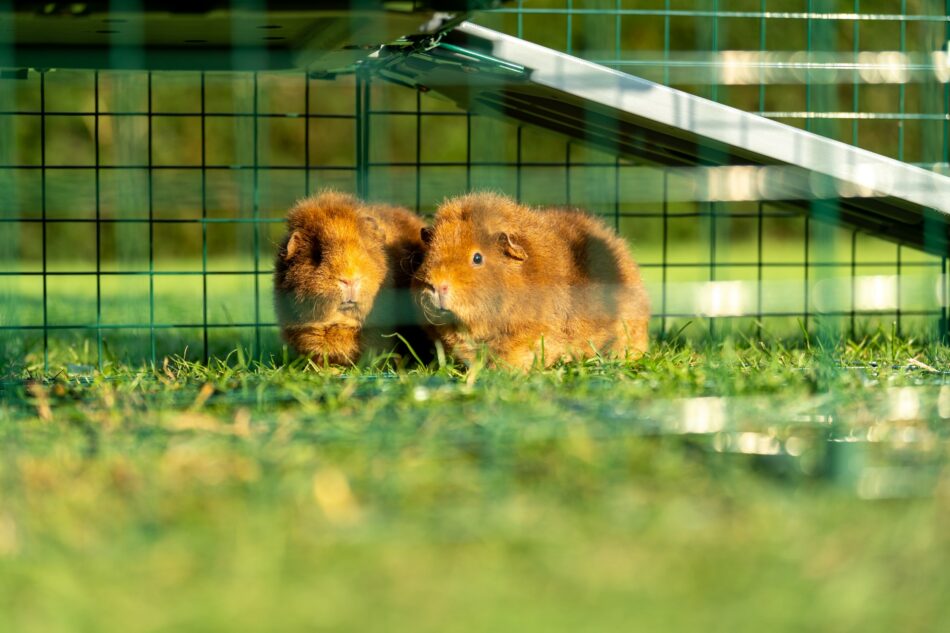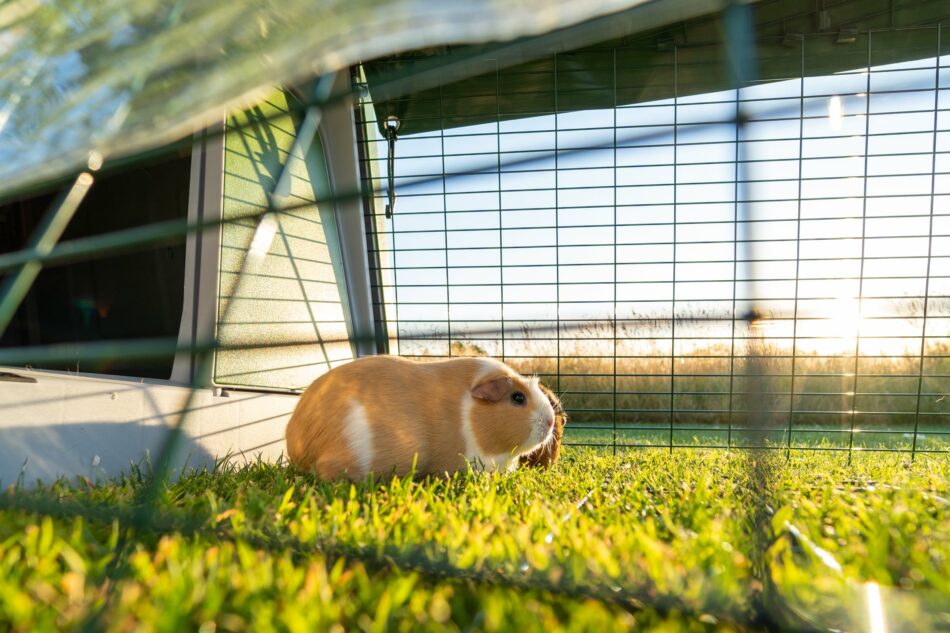How to keep guinea pigs cool in summer
Wondering how to keep guinea pigs cool in summer? Making adjustments for your guinea pigs, particularly if they’re housed outdoors, is a necessity of the season. Because cavies can’t sweat and have compact bodies with dense fur, keeping them cool during the summer is critical to their survival. Here’s why guinea pigs are heat-sensitive, some practical ways to keep cavies cool, and how to spot heatstroke in guinea pigs.
Keeping your cavies cool
If you take a look at guinea pig anatomy, you’ll quickly see why they aren’t built for extreme temperatures. They don’t have sweat glands to help release heat, and their rapid respiratory rate is inefficient in hot or humid air. And, while their potato-shaped bodies may be part of their charm, their physique traps more heat than needed during hot weather.
Ideal temperatures for guinea pigs lie between 65-75°F. Once ambient temperatures exceed 80°F, the risk of heat stress rises. At temperatures of 85°F or higher, guinea pigs can develop heatstroke quickly. Guinea pigs housed outdoors may be more tolerant to elevated temperatures, but it’s critical to monitor your pets closely once the temperatures reach these danger zones.
How to keep guinea pigs cool
As long as the temperatures in your guinea pigs’ area can be kept consistent, your cavies can enjoy summer safely. The caveat to guinea pig breeds that can tolerate higher temperatures are Skinny Pigs, which should never be kept outside due to their lack of fur. Here are some ways to help your fully-furred cavies stay cool during the summer months.
Create shade
An insulated guinea pig hutch is a must when combating extreme temperatures. And to enhance its performance, keep your guinea pigs’ hutch in a shaded area with good ventilation. Under shade trees, a covered patio, or next to a north-facing wall will allow for optimum shade. Add guinea pig run covers to provide shade outside of the hutch, and consider reflective sheeting to help redirect sun rays.
Offer cool elements
Ceramic tiles or terracotta saucers in your guinea pigs’ run aren’t just aesthetically pleasing. Chill them in your refrigerator or freezer before adding them to your cavies’ run for a cooling element they can flop onto. You can also freeze water bottles and wrap them in a thin towel for your guinea pigs to snuggle up against.
Up the airflow
Oscillating or box fans can circulate stagnant air, which can reduce the temperatures around your guinea pigs setup. Angle them so that their breeze passes over and through their run, but not directly onto your cavies to prevent respiratory issues. In drier climates, you can add a patio mister in front of a fan for an evaporative cooling effect.
Boost their hydration
Making sure your guinea pigs are well hydrated in the hottest months is vital to their wellbeing. Mount extra water bottles or crocks around their setup, and refresh them daily with cool (not icy) water. Offer water-rich vegetables like cucumber, romaine lettuce, and bell pepper in a hanging guinea pig treat holder, but remember to offer these treats in moderation.
Rethink bedding
Summer isn’t the time for deep layers of bedding. Swap shavings and straw for thin fleece liners over absorbent pads to wick away excess moisture and to improve airflow. If you choose to stick with bedding, opt for thin layers of recycled paper pup or pine pellets to avoid trapping heat. Remember to spot clean regularly, as wet bedding warms up quickly and increases humidity.
Schedule playtime wisely
Guinea pig play pens and tunnels are best to be made available during the early morning and late evening hours to avoid the hottest part of the day. And, remember to check how hot any surface is before placing your guinea pig on it to play — especially pavement, synthetic grass, or decking. A pop-up guinea pig playpen with flooring can be used for quick play sessions without having to worry about their feet.
Bring them inside
If your area has sustained temperatures above 80°F, it may be time to bring your cavies indoors for the summer. It’s important to remember that if you bring your guinea pigs inside, they’ll need to remain in this climate controlled setting until indoor and outdoor temperatures are in alignment. If you do bring your cavies in for the summer, keep them in a room with adequate airflow and away from windows, appliances, and upper levels, which are typically the warmest spots in a home.
Signs of heatstroke in guinea pigs
If your cavies are weathering the summer outside, it’s important to be aware of the signs of heat stress and heatstroke in guinea pigs. Heat stress can rapidly progress to heatstroke, at which point a guinea pig’s vital organs begin shutting down. Signs of heat stress in guinea pigs include:
- Rapid, shallow breathing
- Lethargy
- Warm, reddened ears
- Fur damp from saliva
If left unaddressed, heat stress can quickly turn into heatstroke. Sings of heatstroke in guinea pigs include:
- Open-mouthed panting
- Weakness or staggering
- Drooling or frothy saliva
- Convulsions or collapse
If you suspect heat stress in your guinea pigs, quick action can save their lives. Move them to a cooler area right away, and lower their body temperature slowly. Lightly mist a cloth with cool (not cold) water and wipe their ears, feet, and belly. Don’t submerge or drench your guinea pig in cool water, as a sudden change in temperature can cause shock. Offer cool water, but don’t force them to drink. If you don’t see noticeable improvement a few minutes after these measures, it’s time to call the veterinarian.
Omlet and your guinea pigs
Not every climate is kind to cavies all year round, but our guinea pig products keep them as comfortable as possible in any setting. From supportive outdoor guinea pig hutches to guinea pig playpens that can easily be set up indoors for temporary accommodations, we’ve invented what you need to keep your cavies cool and comfortable — inside and out.
This entry was posted in Guinea Pigs


